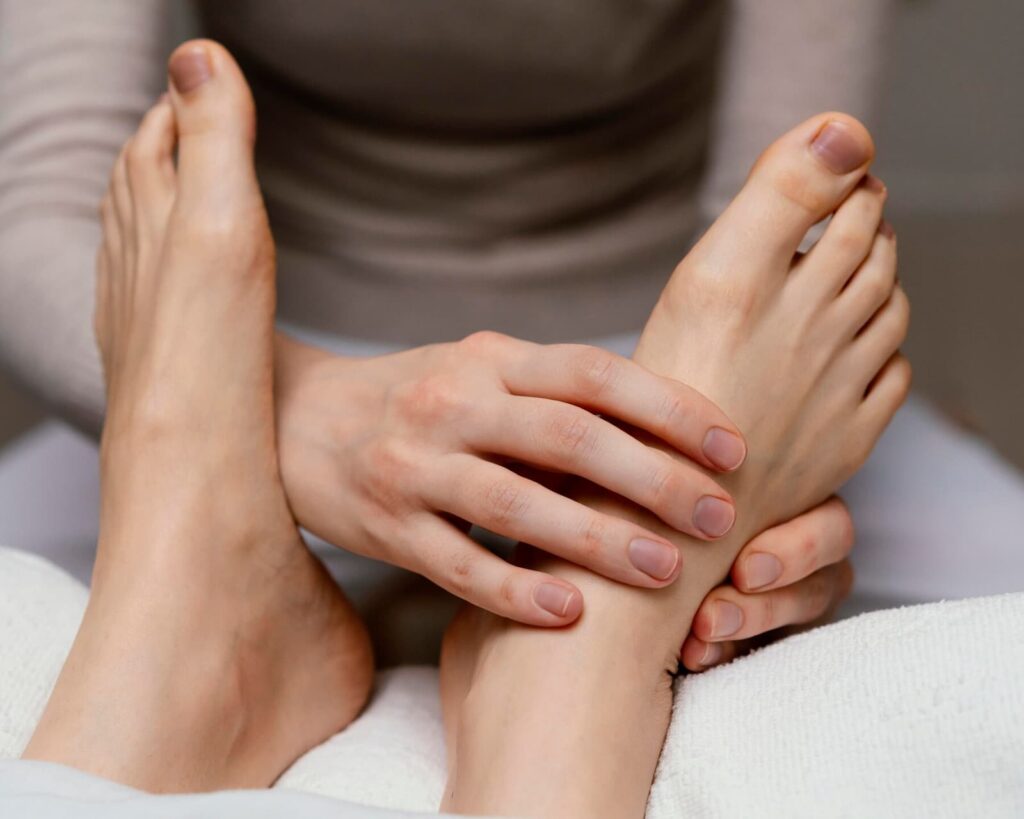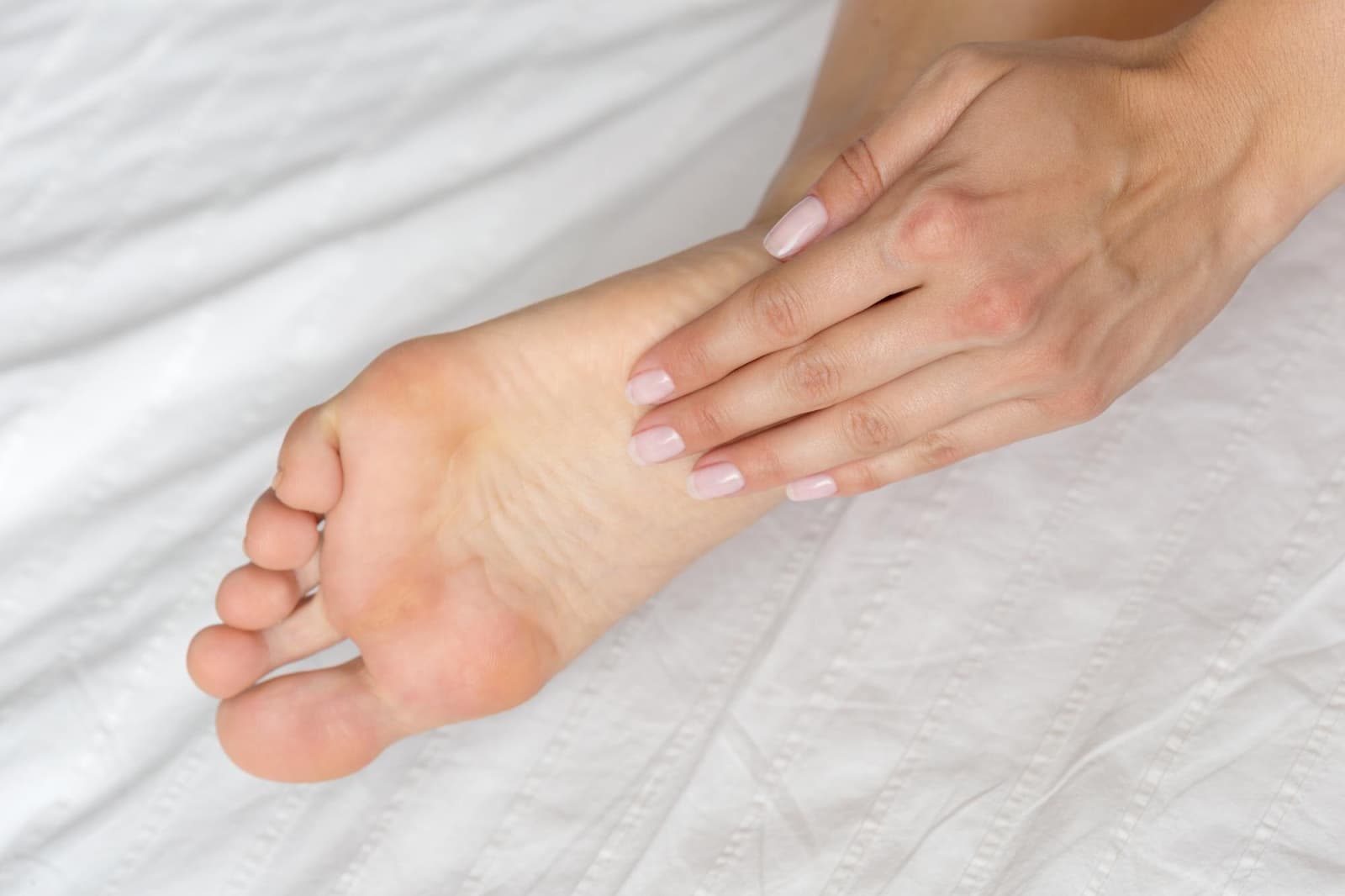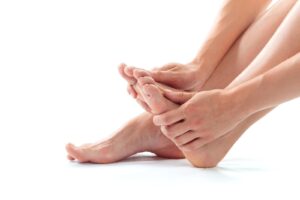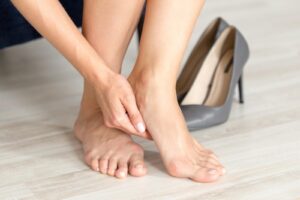Foot drop, also known as dropped foot, is a condition characterized by weakness in one or both legs that hinders the ability to move the ankle and point the toes upward. This impairment can lead to difficulties in walking, posing risks of tripping and falling. Understanding the signs of healing foot drop is crucial for effective management and recovery.
Key Questions Addressed in this Article:
- What are the signs and symptoms of drop foot?;
- How is drop foot diagnosed?;
- When should you see a doctor for drop foot symptoms?;
- What treatment options are available for managing drop foot?;
- How can physical therapy help in foot drop rehabilitation?;
- What role does nerve stimulation play in treating foot drop?;
- When is surgery recommended for foot drop, and what are the common surgical procedures?
What Are The Signs And Symptoms Of Drop Foot?
Recognizing the Telltale Signs
When experiencing foot drop, individuals often encounter a distinct weakness when attempting to move their foot upwards and around the ankle. This weakness manifests as a heavy sensation in the foot, accompanied by potential tingling or numbness. Furthermore, curling toes and dragging or catching of the foot during regular walking are common indicators of foot drop. Failure to lift the knee sufficiently to prevent the foot from touching the ground exacerbates these symptoms, highlighting the challenges faced by those with this condition.
Understanding the Impact on Mobility
The consequences of foot drop extend beyond physical discomfort, significantly affecting mobility and stability while walking. The inability to clear the foot properly during each step increases the likelihood of stumbling or falling, posing safety concerns for individuals with this condition. Moreover, compensatory movements such as excessive lifting and bending of the knee and hip may develop over time, leading to additional musculoskeletal issues and an elevated risk of falls.
Prevalence and Preventive Measures
Statistics reveal that falls represent a significant health risk, with approximately 1 in 3 Australians aged 65 and above being hospitalized annually due to fall-related injuries. However, it is essential to recognize that the majority of falls are preventable through proactive measures. By addressing foot drop symptoms promptly and implementing appropriate interventions, individuals can mitigate the associated risks and enhance their overall quality of life.
Diagnosis
Conducting a Comprehensive Evaluation
Diagnosing foot drop involves a series of assessments aimed at identifying the underlying causes and determining the most suitable treatment approach. Healthcare providers typically employ various diagnostic methods, including physical examinations, imaging tests, and nerve assessments, to accurately diagnose the condition and tailor interventions accordingly.
Physical Examination
During a physical examination, healthcare professionals evaluate muscle strength, reflexes, and sensory responses in the affected leg to assess the extent of motor impairment. Observing gait patterns and analyzing movement patterns provide valuable insights into the functional limitations caused by foot drop, guiding the development of personalized treatment plans.
Imaging Tests
Imaging techniques such as X-rays, magnetic resonance imaging (MRI), and computed tomography (CT) scans may be utilized to visualize structural abnormalities or injuries affecting the nerves, muscles, or bones in the lower extremities. These diagnostic tools help clinicians identify anatomical irregularities contributing to foot drop and facilitate targeted interventions to address the root cause of the condition.
Nerve Tests
Nerve conduction studies and electromyography (EMG) are specialized tests used to assess nerve function and muscular activity in individuals with suspected nerve damage or dysfunction. By measuring electrical impulses along the nerves and muscles, healthcare providers can pinpoint areas of impairment and devise tailored treatment strategies to promote nerve regeneration and restore optimal motor function.
Do I Need to See a Doctor?
Seeking Timely Medical Intervention
If you experience persistent weakness, numbness, or difficulty moving your foot, seeking medical attention is crucial to receive a comprehensive evaluation and appropriate care. A healthcare provider specializing in neurology or orthopedics can conduct a thorough assessment, determine the underlying cause of your symptoms, and recommend a personalized treatment plan to address your specific needs effectively.
Collaborating with Healthcare Professionals
Collaborating with a multidisciplinary team of healthcare professionals, including physicians, physical therapists, and rehabilitation specialists, is essential for managing foot drop comprehensively. By leveraging the expertise of diverse specialists, individuals can access a range of therapeutic modalities and interventions tailored to promote healing, improve mobility, and enhance overall well-being.
Embracing a Holistic Approach
In addition to conventional medical treatments, incorporating complementary therapies such as acupuncture, massage therapy, and yoga can complement traditional interventions and support the healing process. Adopting a holistic approach to foot drop management encompasses physical, emotional, and mental well-being, fostering a balanced and sustainable recovery journey.

Braces
Braces play a pivotal role in supporting the affected foot and ankle, providing stability and facilitating proper alignment during weight-bearing activities. Ankle-foot orthoses (AFOs) are commonly prescribed braces designed to assist individuals with foot drop by preventing excessive plantar flexion and promoting dorsiflexion, enhancing gait efficiency and reducing the risk of falls.
| Type of Brace | Description |
|---|---|
| Ankle-foot orthosis (AFO) | A rigid or flexible brace worn around the ankle and foot to control motion and maintain proper alignment during walking. |
| Dynamic ankle-foot orthosis (DAFO) | A dynamic brace incorporating hinges or springs to facilitate natural movement patterns and provide customized support based on individual needs. |
| Posterior leaf spring AFO | A lightweight brace featuring a leaf spring design positioned behind the calf to assist with dorsiflexion and promote a more fluid gait cycle. |
Physical Therapy
Physical therapy plays a fundamental role in foot drop rehabilitation, focusing on strengthening weakened muscles, improving range of motion, and enhancing balance and coordination. Therapeutic exercises, gait training, and functional activities are integral components of physical therapy programs tailored to address the specific impairments associated with foot drop and optimize functional outcomes.
- Strengthening Exercises: Targeted exercises to strengthen the muscles of the lower leg, foot, and ankle, enhancing stability and mobility;
- Stretching Techniques: Gentle stretching routines to improve flexibility, alleviate muscle tightness, and enhance joint mobility for enhanced functional capacity;
- Balance Training: Balance exercises and proprioceptive drills to enhance postural control, reduce the risk of falls, and promote safe ambulation.
Nerve Stimulation
Nerve stimulation techniques such as transcutaneous electrical nerve stimulation (TENS) and functional electrical stimulation (FES) offer non-invasive approaches to neuromuscular re-education and muscle activation in individuals with foot drop. By delivering controlled electrical impulses to targeted nerves and muscles, these modalities promote motor recovery, enhance muscle recruitment, and facilitate improved movement patterns.
- Transcutaneous Electrical Nerve Stimulation (TENS): Utilizes low-voltage electrical currents to stimulate sensory nerves and alleviate pain, promoting circulation and enhancing muscle function;
- Functional Electrical Stimulation (FES): Involves the application of electrical impulses to specific muscles or nerves to elicit contractions, improve muscle strength, and restore functional movement patterns.
Surgery
In cases where conservative treatments fail to yield significant improvements or when structural abnormalities require surgical intervention, foot drop surgery may be recommended to address underlying issues and restore optimal function. Surgical procedures such as tendon transfers, nerve decompression, or fusion surgeries aim to correct anatomical defects, alleviate nerve compression, and enhance motor control for improved mobility and quality of life.
| Surgical Procedure | Indications |
|---|---|
| Tendon Transfer Surgery | Realigns tendons to restore proper muscle function and improve foot and ankle movement. |
| Nerve Decompression | Relieves pressure on compressed nerves to alleviate symptoms and promote nerve regeneration. |
| Fusion Surgery | Stabilizes joints and corrects deformities to enhance structural integrity and facilitate weight-bearing activities. |
Conclusion
In conclusion, recognizing the signs of healing foot drop, including those associated with lisfranc injury bruising, is essential for early intervention, effective management, and successful recovery. Through collaborative efforts with healthcare professionals, diligent adherence to treatment protocols, and a commitment to self-care, individuals with foot drop can overcome challenges, improve mobility, and enhance their overall quality of life.


